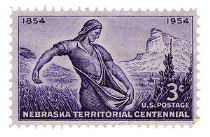Extension, Cooperative

Nebraska Agricultural Experiment Station: Historical Research Bulletins
Effect of Time of Cutting on Yield and Botanical Composition of Prairie Hay in Southeastern Nebraska
Date of this Version
11-1957
Document Type
Article
Citation
Conard, Elverne C. and Arthaud, Vincent H. (1957) Effect of time of cutting on yield and botanical composition of prairie hay in southeastern Nebraska (Research Bulletin: Bulletin of the Agricultural Experiment Station of Nebraska No. 184)
Abstract
Approximately three and one-third million acres of native prairie are harvested annually in Nebraska for hay. In the four-year period 1948-1951, the State ranked first in wild hay production with an average yield of more than two and one-quarter million tons per year. This crop is an important natural resource in Nebraska's livestock industry. Studies were initiated in 1945 to determine the effects of time of cutting on the yield and feeding value of prairie hay in southeastern Nebraska. The studies were continued through the summer of 1952 to determine the effects of different cutting treatments on the vigor and botanical composition of the vegetation. A separate study was initiated in 1948 and continued through 1952 to determine the effect of time of harvesting the aftermath crop in the fall on the yield of hay the following summer.
Included in
Agriculture Commons, Agronomy and Crop Sciences Commons, Biodiversity Commons, Botany Commons, Other Ecology and Evolutionary Biology Commons


Comments
ISSN 0097-1514